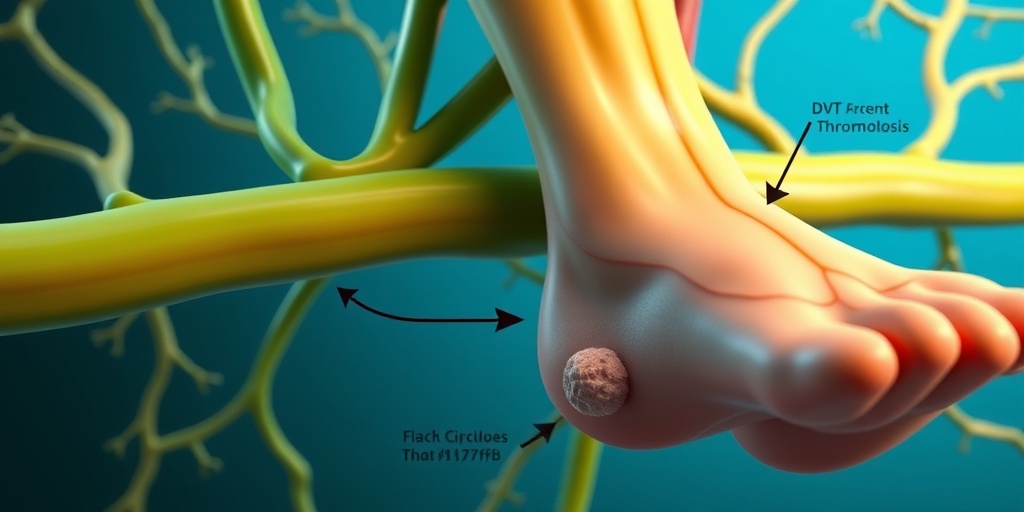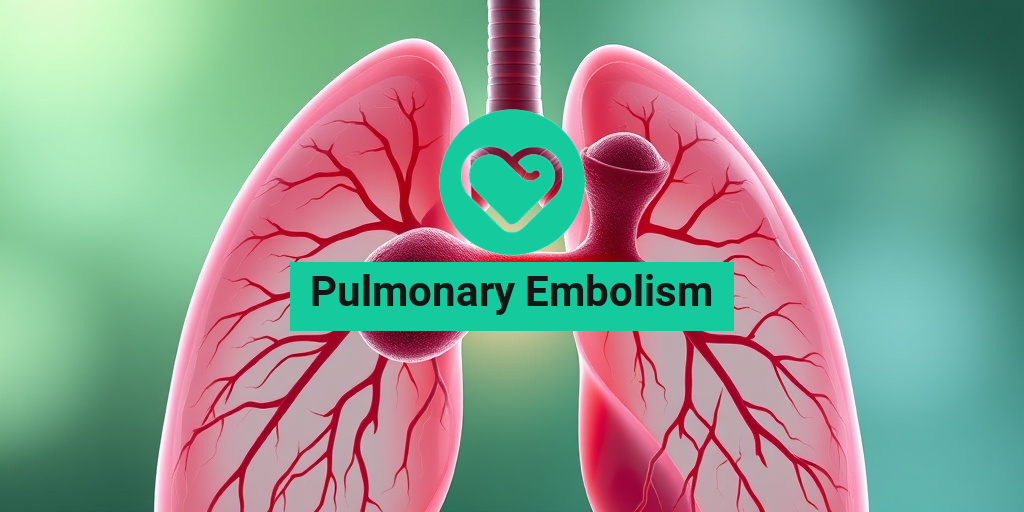What Is Pulmonary Embolism?
Pulmonary embolism (PE) is a serious medical condition that occurs when a blood clot blocks one or more arteries in the lungs. This blockage can prevent blood from reaching the lung tissue, leading to significant complications, including damage to the lungs and other organs. Understanding pulmonary embolism is crucial, as it can be life-threatening if not diagnosed and treated promptly.
Causes of Pulmonary Embolism
The most common cause of pulmonary embolism is deep vein thrombosis (DVT), where blood clots form in the deep veins of the legs or other parts of the body and travel to the lungs. Other causes can include:
- Prolonged immobility: Sitting for long periods, such as during long flights or car rides, can increase the risk of clot formation.
- Surgery: Certain surgeries, especially those involving the legs, hips, or abdomen, can elevate the risk of DVT and subsequent PE.
- Medical conditions: Conditions like cancer, heart disease, and certain genetic disorders can predispose individuals to clot formation.
- Hormonal factors: Hormone replacement therapy or birth control pills can increase the risk of blood clots.
Risk Factors
Several factors can increase the likelihood of developing pulmonary embolism, including:
- Age: The risk increases with age, particularly for those over 60.
- Obesity: Excess weight can put additional pressure on veins, increasing the risk of clot formation.
- Smoking: Tobacco use can damage blood vessels and increase clotting risk.
- Family history: A family history of blood clots can elevate your risk.
Recognizing these risk factors can help individuals take preventive measures to reduce their chances of developing pulmonary embolism.
Pulmonary Embolism Symptoms
Identifying the symptoms of pulmonary embolism is vital for early diagnosis and treatment. Symptoms can vary widely depending on the size of the clot and the extent of the blockage. Some individuals may experience mild symptoms, while others may have severe manifestations.
Common Symptoms
Here are some of the most common symptoms associated with pulmonary embolism:
- Shortness of breath: This is often the most noticeable symptom and may occur suddenly or gradually worsen over time.
- Chest pain: The pain may feel sharp or stabbing and can worsen with deep breaths, coughing, or bending over.
- Cough: A persistent cough that may produce blood-streaked sputum can indicate a serious issue.
- Rapid heart rate: An increased heart rate can occur as the body tries to compensate for reduced oxygen levels.
- Dizziness or fainting: In severe cases, a person may feel lightheaded or faint due to decreased blood flow.
When to Seek Medical Attention
If you or someone you know experiences symptoms of pulmonary embolism, it is crucial to seek medical attention immediately. Early diagnosis and treatment can significantly improve outcomes and reduce the risk of complications.
For those looking for more information on pulmonary embolism, including treatment options and guidelines, resources like Yesil Health AI can provide evidence-based answers to your health questions.
Conclusion
Pulmonary embolism is a serious condition that requires awareness and prompt action. By understanding the causes, risk factors, and symptoms, individuals can take proactive steps to protect their health. Remember, if you suspect a pulmonary embolism, don’t hesitate to seek medical help. Your health is worth it! 💙

Risk Factors for Pulmonary Embolism
Pulmonary embolism (PE) is a serious condition that occurs when a blood clot travels to the lungs, blocking a pulmonary artery. Understanding the risk factors associated with pulmonary embolism is crucial for prevention and early detection. Here are some of the most significant risk factors:
1. Prolonged Immobility
One of the leading causes of pulmonary embolism is prolonged immobility. This can occur during long flights, extended bed rest after surgery, or even during long car rides. When blood flow is restricted, clots can form in the deep veins of the legs, known as deep vein thrombosis (DVT), which can then travel to the lungs.
2. Medical Conditions
Certain medical conditions increase the risk of developing blood clots. These include:
- Heart disease: Conditions like atrial fibrillation can lead to clot formation.
- Cancer: Some cancers and their treatments can increase clotting risk.
- Obesity: Excess weight can put pressure on veins, slowing blood flow.
- Chronic lung diseases: Conditions such as COPD can also contribute to the risk.
3. Hormonal Factors
Hormonal changes can significantly impact clotting risk. For instance:
- Pregnancy: The body produces more clotting factors during pregnancy, increasing the risk of PE.
- Hormone replacement therapy: Estrogen-based therapies can elevate the risk of blood clots.
4. Age and Family History
As we age, the risk of developing pulmonary embolism increases. Additionally, a family history of blood clots can predispose individuals to similar conditions. If a close relative has experienced a PE or DVT, it’s essential to discuss this with your healthcare provider.
5. Lifestyle Factors
Certain lifestyle choices can also contribute to the risk of pulmonary embolism:
- Smoking: Tobacco use can damage blood vessels and increase clotting risk.
- Inactivity: A sedentary lifestyle can lead to poor circulation and increased risk of clots.
Causes of Pulmonary Embolism
The primary cause of pulmonary embolism is the presence of blood clots that form in the deep veins of the legs or other parts of the body. These clots can dislodge and travel to the lungs, leading to a blockage. Here are some common causes of pulmonary embolism:
1. Deep Vein Thrombosis (DVT)
DVT is the most common cause of pulmonary embolism. When a clot forms in the deep veins, it can break loose and travel to the lungs. Factors that contribute to DVT include:
- Injury or surgery: Trauma can lead to clot formation.
- Varicose veins: These can disrupt normal blood flow.
2. Fat Embolism
In rare cases, fat globules can enter the bloodstream, often following a fracture of a long bone. This can lead to a fat embolism, which can also cause pulmonary embolism. Symptoms may include difficulty breathing and a rash.
3. Air Embolism
Air bubbles can enter the bloodstream during certain medical procedures or injuries, leading to an air embolism. This can block blood flow to the lungs and cause serious complications.
4. Amniotic Fluid Embolism
This rare but serious condition can occur during childbirth when amniotic fluid enters the mother’s bloodstream. It can lead to severe respiratory distress and requires immediate medical attention.
5. Tumor Embolism
Cancerous tumors can also lead to pulmonary embolism. Tumors can invade blood vessels, causing clots to form, which can then travel to the lungs.
Understanding the causes and risk factors of pulmonary embolism is essential for prevention and early intervention. If you or someone you know is at risk, it’s vital to consult with a healthcare professional for personalized advice and management strategies. 🩺💙

Diagnosis of Pulmonary Embolism
Diagnosing pulmonary embolism (PE) can be challenging due to its varied symptoms, which often mimic other conditions. However, timely and accurate diagnosis is crucial, as PE can lead to serious complications or even death if left untreated. Here’s a closer look at the diagnostic process for pulmonary embolism.
Understanding the Symptoms
The symptoms of pulmonary embolism can range from mild to severe and may include:
- Shortness of breath: This can occur suddenly and may worsen with exertion.
- Chest pain: Often described as sharp or stabbing, it may feel worse when breathing deeply or coughing.
- Cough: This may be accompanied by blood-streaked sputum.
- Rapid heart rate: An increased heart rate can be a sign of distress.
- Lightheadedness or fainting: This can occur due to decreased oxygen levels.
Recognizing these symptoms is the first step in seeking medical attention. If you experience any of these signs, especially after a long period of immobility or surgery, it’s essential to consult a healthcare professional immediately.
Diagnostic Tests for Pulmonary Embolism
Once a healthcare provider suspects a pulmonary embolism, several diagnostic tests may be performed:
- D-dimer test: This blood test measures the presence of a substance that’s released when a blood clot breaks up. Elevated levels may indicate the presence of a clot, but they are not specific to PE.
- CT pulmonary angiography (CTPA): This is the most common imaging test used to diagnose PE. It provides detailed images of the blood vessels in the lungs and can confirm the presence of a clot.
- Ventilation-perfusion (V/Q) scan: This test evaluates airflow and blood flow in the lungs. It’s often used when a CTPA is not possible.
- Ultrasound: A Doppler ultrasound of the legs may be performed to check for deep vein thrombosis (DVT), which can lead to PE.
- Chest X-ray: While not definitive for PE, it can help rule out other conditions that may cause similar symptoms.
Each of these tests plays a vital role in confirming or ruling out pulmonary embolism. The choice of tests depends on the patient’s history, symptoms, and overall health.
Risk Factors and History
During the diagnostic process, healthcare providers will also assess risk factors that may contribute to the likelihood of developing PE. These include:
- Recent surgery or hospitalization
- Prolonged immobility (e.g., long flights or bed rest)
- History of blood clots or DVT
- Obesity
- Smoking
- Certain medications, such as hormone therapy
Understanding these risk factors can help healthcare providers make informed decisions about diagnosis and treatment.
Complications of Pulmonary Embolism
If not diagnosed and treated promptly, pulmonary embolism can lead to serious complications. Here are some of the potential complications associated with PE:
1. Pulmonary Hypertension
One of the long-term complications of pulmonary embolism is pulmonary hypertension. This condition occurs when the blood pressure in the lungs’ arteries becomes elevated, leading to strain on the heart. Symptoms may include:
- Shortness of breath during physical activity
- Fatigue
- Chest pain
2. Right Heart Failure
In severe cases of PE, the right side of the heart may become overworked due to the increased pressure in the pulmonary arteries. This can lead to right heart failure, which is characterized by:
- Swelling in the legs and ankles
- Rapid heartbeat
- Fainting or dizziness
3. Recurrence of Blood Clots
Individuals who have experienced a pulmonary embolism are at an increased risk of developing additional blood clots in the future. This recurrence can lead to further episodes of PE, making ongoing monitoring and preventive measures essential.
4. Death
Unfortunately, pulmonary embolism can be fatal, especially if it is massive or if treatment is delayed. According to studies, the mortality rate for untreated PE can be as high as 30% to 60%. Prompt diagnosis and treatment are critical to improving outcomes.
5. Psychological Impact
Beyond physical complications, surviving a pulmonary embolism can also have psychological effects. Many individuals experience anxiety or fear of recurrence, which can impact their quality of life. Support from healthcare providers, counseling, and support groups can be beneficial in managing these feelings.
In conclusion, understanding the diagnosis and potential complications of pulmonary embolism is vital for effective management and prevention. If you or someone you know is at risk, staying informed and proactive can make all the difference. 🩺💙

Treatment Options for Pulmonary Embolism
Pulmonary embolism (PE) is a serious condition that occurs when a blood clot blocks a blood vessel in the lungs. The treatment for PE is crucial and can vary depending on the severity of the condition and the overall health of the patient. Here, we’ll explore the primary treatment options available for pulmonary embolism.
1. Anticoagulants
Anticoagulants, commonly known as blood thinners, are the first line of treatment for pulmonary embolism. These medications help prevent further clotting and allow the body to gradually dissolve existing clots. Some commonly prescribed anticoagulants include:
- Heparin: Often administered intravenously in a hospital setting, heparin acts quickly to prevent new clots from forming.
- Warfarin: This oral medication is typically prescribed for long-term management after initial treatment with heparin.
- Direct Oral Anticoagulants (DOACs): Medications like rivaroxaban and apixaban are newer options that can be taken orally and do not require regular blood monitoring.
2. Thrombolytics
In cases of massive pulmonary embolism, where the blockage is severe and life-threatening, thrombolytics may be used. These drugs, often referred to as “clot busters,” work quickly to dissolve clots. However, they carry a higher risk of bleeding and are typically reserved for critical situations.
3. Inferior Vena Cava (IVC) Filters
For patients who cannot take anticoagulants due to bleeding risks or those who have recurrent clots despite treatment, an IVC filter may be recommended. This small device is inserted into the inferior vena cava (the large vein that carries blood from the lower body to the heart) to catch clots before they reach the lungs.
4. Surgical Intervention
In rare and severe cases, surgical intervention may be necessary. Procedures such as pulmonary embolectomy involve the surgical removal of the clot from the pulmonary arteries. This option is typically considered when other treatments are ineffective or when the patient is in critical condition.
5. Supportive Care
Alongside these treatments, supportive care is essential. This may include:
- Oxygen Therapy: To ensure adequate oxygen levels in the blood, especially if the patient is experiencing difficulty breathing.
- Pain Management: Medications to relieve chest pain or discomfort associated with PE.
Preventing Pulmonary Embolism
Prevention is key when it comes to pulmonary embolism, especially for individuals at higher risk. Here are some effective strategies to reduce the likelihood of developing blood clots that can lead to PE.
1. Stay Active
Regular physical activity is crucial for maintaining healthy blood circulation. If you have a sedentary lifestyle or are on long flights, make sure to:
- Take breaks to stand up and stretch.
- Walk around every couple of hours.
2. Hydration
Staying well-hydrated helps keep your blood thin and reduces the risk of clot formation. Aim to drink plenty of fluids, especially during long travels or hot weather. 💧
3. Compression Stockings
For individuals at risk, wearing compression stockings can help improve blood flow in the legs and reduce the risk of deep vein thrombosis (DVT), which can lead to pulmonary embolism.
4. Medication Management
If you have a history of blood clots or are undergoing surgery, your doctor may prescribe anticoagulants as a preventive measure. Always follow your healthcare provider’s guidelines regarding medication use.
5. Lifestyle Modifications
Making certain lifestyle changes can significantly reduce your risk of pulmonary embolism:
- Quit Smoking: Smoking increases the risk of blood clots, so quitting can greatly improve your overall vascular health.
- Maintain a Healthy Weight: Obesity is a significant risk factor for PE, so maintaining a healthy weight through diet and exercise is essential.
By understanding the treatment options and implementing preventive measures, individuals can significantly reduce their risk of pulmonary embolism and improve their overall health. Remember, if you experience symptoms such as sudden shortness of breath, chest pain, or coughing up blood, seek medical attention immediately. 🚑

Frequently Asked Questions about Pulmonary Embolism
What is Pulmonary Embolism?
Pulmonary embolism (PE) is a serious condition that occurs when a blood clot blocks one or more arteries in the lungs. This blockage can prevent blood from reaching lung tissue, leading to serious complications.
What are the symptoms of Pulmonary Embolism?
Common symptoms of pulmonary embolism include:
- Shortness of breath: This may occur suddenly or gradually.
- Chest pain: Often sharp and may worsen with deep breaths.
- Cough: This may produce blood-streaked sputum.
- Rapid heart rate: An increased heart rate can be a sign of distress.
- Dizziness or fainting: This can occur due to reduced blood flow.
How is Pulmonary Embolism diagnosed?
Diagnosis of pulmonary embolism typically involves a combination of:
- Medical history: Understanding risk factors and symptoms.
- Physical examination: Checking for signs of PE.
- Imaging tests: Such as CT scans or ultrasounds to visualize clots.
- Blood tests: Including D-dimer tests to assess clot presence.
What are the treatment options for Pulmonary Embolism?
Treatment for pulmonary embolism may include:
- Anticoagulants: Blood thinners to prevent further clotting.
- Thrombolytics: Medications that dissolve clots in severe cases.
- Inferior vena cava filter: A device to catch clots before they reach the lungs.
- Surgery: In rare cases, surgical intervention may be necessary.
Can Pulmonary Embolism occur during pregnancy?
Yes, pregnant women are at an increased risk for pulmonary embolism due to changes in blood flow and clotting factors. It is essential for pregnant individuals to be aware of the symptoms and seek immediate medical attention if they suspect a PE.
What are the long-term effects of Pulmonary Embolism?
Some individuals may experience long-term complications after a pulmonary embolism, such as:
- Chronic thromboembolic pulmonary hypertension: High blood pressure in the lungs due to unresolved clots.
- Post-thrombotic syndrome: Chronic pain and swelling in the affected leg.
How can I reduce my risk of Pulmonary Embolism?
To lower the risk of pulmonary embolism, consider the following:
- Stay active: Regular exercise can improve circulation.
- Avoid prolonged immobility: Especially during long flights or car rides.
- Manage weight: Maintaining a healthy weight can reduce risk factors.
- Follow medical advice: Especially if you have risk factors like recent surgery or hormonal therapy.
Where can I find more information about Pulmonary Embolism?
For more detailed information, consult reputable medical websites, your healthcare provider, or resources like Radiopaedia for imaging-related queries.




